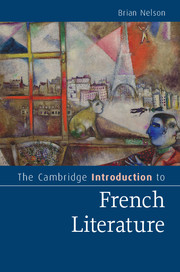Book contents
- Frontmatter
- Dedication
- Contents
- Preface
- Acknowledgements
- Chronology
- 1 Villon: a dying man
- 2 Rabelais: the uses of laughter
- 3 Montaigne: self-portrait
- 4 Corneille: heroes and kings
- 5 Racine: in the labyrinth
- 6 Molière: new forms of comedy
- 7 La Fontaine: the power of fables/fables of power
- 8 Madame de Lafayette: the birth of the modern novel
- 9 Voltaire: the case for tolerance
- 10 Rousseau: man of feeling
- 11 Diderot: the enlightened sceptic
- 12 Laclos: dangerous liaisons
- 13 Stendhal: the pursuit of happiness
- 14 Balzac: ‘All is true’
- 15 Hugo: the divine stenographer
- 16 Baudelaire: the streets of Paris
- 17 Flaubert: the narrator vanishes
- 18 Zola: the poetry of the real
- 19 Huysmans: against nature
- 20 Mallarmé: the magic of words
- 21 Rimbaud: somebody else
- 22 Proust: the self, time and art
- 23 Jarry: the art of provocation
- 24 Apollinaire: impresario of the new
- 25 Breton … Company: Surrealism
- 26 Céline: night journey
- 27 Sartre: writing in the world
- 28 Camus: a moral voice
- 29 Beckett: filling the silence
- 30 French literature into the twenty-first century
- Notes
- Further reading
- Index of authors and titles
- Index of genres, movements and concepts
- Cambridge Introductions to …
- References
24 - Apollinaire: impresario of the new
Published online by Cambridge University Press: 05 July 2015
- Frontmatter
- Dedication
- Contents
- Preface
- Acknowledgements
- Chronology
- 1 Villon: a dying man
- 2 Rabelais: the uses of laughter
- 3 Montaigne: self-portrait
- 4 Corneille: heroes and kings
- 5 Racine: in the labyrinth
- 6 Molière: new forms of comedy
- 7 La Fontaine: the power of fables/fables of power
- 8 Madame de Lafayette: the birth of the modern novel
- 9 Voltaire: the case for tolerance
- 10 Rousseau: man of feeling
- 11 Diderot: the enlightened sceptic
- 12 Laclos: dangerous liaisons
- 13 Stendhal: the pursuit of happiness
- 14 Balzac: ‘All is true’
- 15 Hugo: the divine stenographer
- 16 Baudelaire: the streets of Paris
- 17 Flaubert: the narrator vanishes
- 18 Zola: the poetry of the real
- 19 Huysmans: against nature
- 20 Mallarmé: the magic of words
- 21 Rimbaud: somebody else
- 22 Proust: the self, time and art
- 23 Jarry: the art of provocation
- 24 Apollinaire: impresario of the new
- 25 Breton … Company: Surrealism
- 26 Céline: night journey
- 27 Sartre: writing in the world
- 28 Camus: a moral voice
- 29 Beckett: filling the silence
- 30 French literature into the twenty-first century
- Notes
- Further reading
- Index of authors and titles
- Index of genres, movements and concepts
- Cambridge Introductions to …
- References
Summary
…fed up with this ancient world
– Apollinaire, ‘Zone’If Alfred Jarry was the agent provocateur of the avant-garde, Guillaume Apollinaire (1880–1918) was, in the words of Roger Shattuck, its impresario. Both in his own work and in his indefatigable activities as critic and propagandist, he championed everything that was new and challenging in the arts in the early twentieth century. His was the most influential new voice in poetry when it was bursting out of old forms and themes to discover what Baudelaire had proclaimed years earlier as the ‘heroism of modern life’. His two major collections of poetry are Alcools (1913) and Calligrammes (1918).
Tradition and modernity
‘What has our culture lost … that the avant-garde had in 1890?’ asks Robert Hughes in the opening chapter of his book The Shock of the New. He answers: ‘Ebullience, idealism, confidence, the belief that there was plenty of territory to explore, and above all the sense that art, in the most disinterested and noble way, could find the necessary metaphors by which a radically changing culture could be explained to its inhabitants.’ The great metaphor of this sense of change – ‘its master-image, the one structure that seemed to gather all the meanings of modernity together’ – was, Hughes suggests, the Eiffel Tower. The Tower was built to serve as the central icon of the 1889 Exposition Universelle (World's Fair), the theme of which was industrial manufacture and transformation. The speed at which culture reinvented itself through technology from around 1880 to the outbreak of the First World War was astonishing. Inventions and discoveries included the automobile, the aeroplane, the telephone, the wireless, the phonograph, the telegraph, the light-bulb, the cinematograph, the gramophone disc, wireless telegraphy, radium and radiography.
[What emerged from] the growth of scientific and technical discovery … was the sense of an accelerated rate of change in all areas of human discourse, including art. From now on the rules would quaver, the fixed canons of knowledge fail, under the pressure of new experience and the demand for new forms to contain it.[…]
- Type
- Chapter
- Information
- The Cambridge Introduction to French Literature , pp. 178 - 182Publisher: Cambridge University PressPrint publication year: 2015

